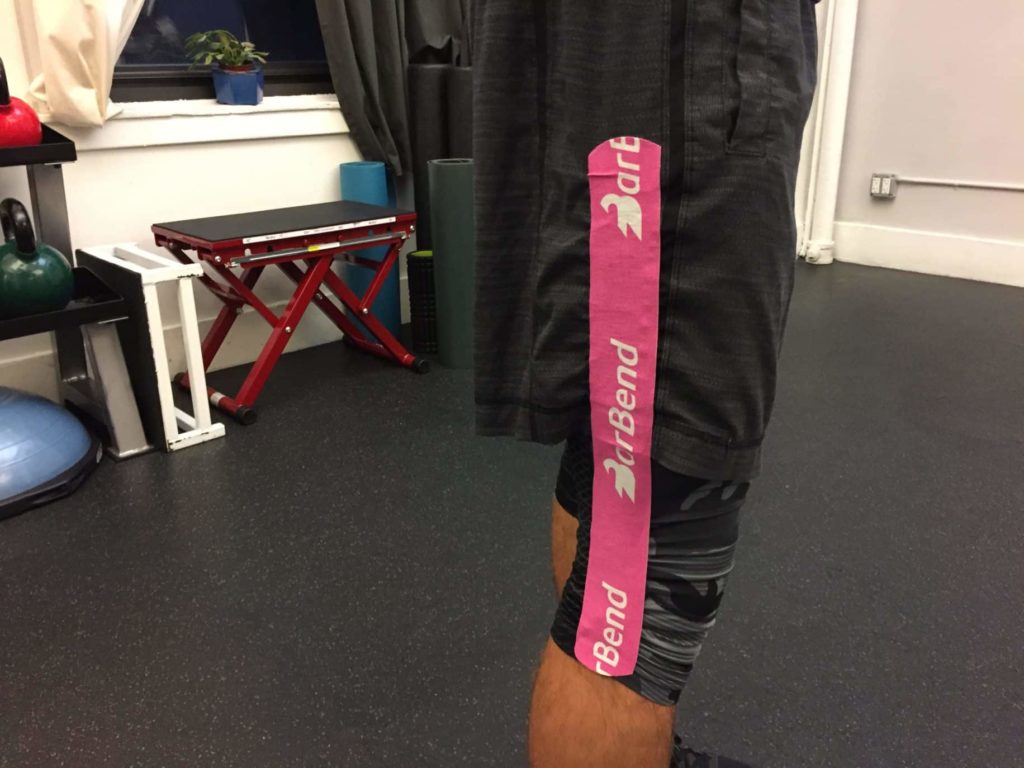Kinesiology tape can be a useful tool to support prolonged performance. Tape’s main function to guide the body’s perception of support and pain through proprioceptive feedback we gain from its touch on the skin. One of the most popular areas athletes like to wear kinesiology tape is the Iliotibial (IT) band.
The IT band is a thick connective tissue band over the lateral thigh that can frequently become painful from overuse. To help us learn how to effectively tape this area we reached out to Joe Gambino, PT, DPT, and CSCS at Perfect Stride Physical Therapy, New York City. Check out the video and in-depth application instructions below.
Note: All motions shown are for informational purposes only. The information in this article and video is not meant to prevent or cure any disease or injury. It’s always a good idea to consult with a medical professional or trainer before attempting any new training methodology. If you experience any sharp pain while exercising, discontinue movements immediately.
Note that the video tape application is over shorts to provide an illustration, and normally the tape would be applied directly to the skin.
[Looking for the perfect tape to fit your strength sport needs? Check out our Best Kinesiology Tapes of 2017 to find your perfect match!]
Why Tape the IT Band?
The IT band when excessively tight can cause discomfort around the distal aspect of the ITB. When our body perceives pain we compensate for it by changing mechanics of movements. If an athlete can work to alleviate pain in certain areas, then they can exercise in safer manner. Below are a few of the anatomical landmarks this method will touch and impact.
- IT Band
- Vastus Lateralis
- Tensor Fascia Latae
Gambino pointed out that IT band issues can vary depending on where an athlete feels pain or tenderness. There’s no one spot that’s the same with this type of issue, so this taping method can assist multiple areas.
1. IT Band Single Strip
To begin, an athlete will measure out a strip of tape that starts just below the knee, and continue up the side of the leg to about ¾ height of the quad. Remember, there will be a 20-50% stretch, so an athlete must be conscious that their strip isn’t too long for the leg. Next, the athlete will round the edges of the tape to avoid getting snagged on clothing.
After the strip has been rounded and measured, the athlete will create a two inch anchor to stick just below the knee. Once the two inch anchor is place, the athlete will apply a 20-50% stretch to the tape and run it up on the side of the leg (where the IT band lies).
Note that in the screenshots tape application is over shorts to provide an illustration, and normally the tape would be applied directly to the skin.

Once the athlete has stuck the entire strip to their leg, then they’ll rub it in for a minute or so to warm-up the heat activated adhesive. Gambino also pointed out to make sure the tape makes contact with the skin, and not on top of clothing.

Tips for IT Band Taping
Along with giving us an IT band taping method, Gambino provided us with a few useful tips to keep in mind.
- Proprioception: Gambino stated that tape itself isn’t the cure for joint instability and pain, but it’s a facilitator for the body’s perception of it. The skin is very sensitive and the tape’s ability to create tension will give the brain feedback to increase stability in the joint being taped.
- Stretch: Another aspect Gambino talked about was the amount of stretch for stability. He said that research is conflicted on how much stretch you need, and he usually does 20-50% stretch to enhance the additional proprioceptive feedback, but an athlete can do upwards to 80% for IT band taping.
- Hair and Taking It Off: If you’re excessively hairy in a specific area, then you’ll pull off little pieces at a time, and use your hand to gently repeatedly chop the tape off (in a karate chopping motion). You can also pinch the skin to release some of the tapes tension, while taking it off in a partitioned manner.
- Cut the Edges: The final tip was the cut the edges of the tape, so it’s rounded. This will prevent the corners from getting caught on edges of clothes and shoes.
[Interested in myofascial release? Read about the best foam roller for the IT band.]
Final Word
Remember that tape isn’t a cure for an injured area, and if your IT band trouble becoming debilitating, then proper medical supervision should be sought out. This simple method can provide an athlete with the perception of stability to prolong their performance when the IT band is giving them trouble.